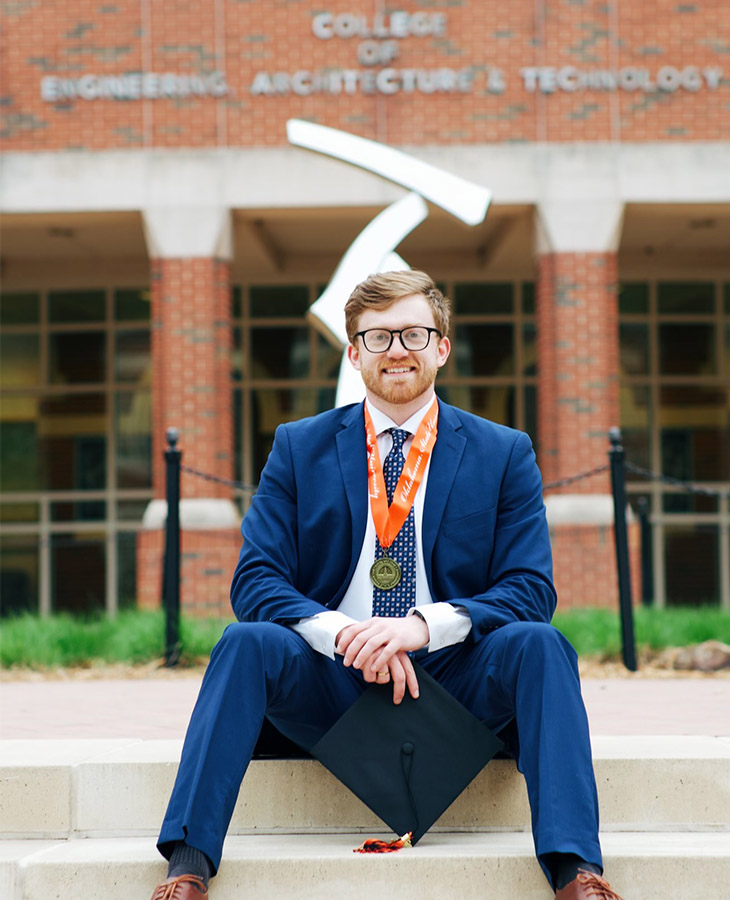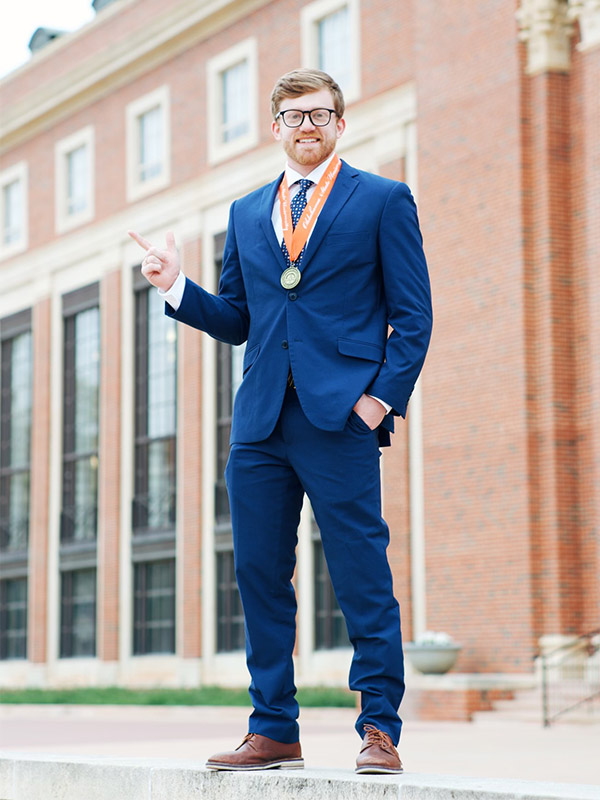
CEAT graduate Manning receives GEM Fellowship
Friday, November 1, 2024
Media Contact: Kristi Wheeler | Manager, CEAT Marketing and Communications | 405-744-5831 | kristi.wheeler@okstate.edu
Although Dawson Manning recently graduated, his academic and career endeavors are just beginning.
Manning earned his Bachelor of Science in Aerospace and Mechanical Engineering and a minor in Physics at the College of Engineering, Architecture and Technology in spring 2024.
He also received the GEM Fellowship provided by the National GEM Consortium. Through this fellowship, Manning accepted NASA’s offer to work with them, where he will spend two summers researching the advancement of aircraft design software at the Glenn Research Center in Cleveland.
Additionally, he is pursuing his Master of Science degree at Texas A&M University while conducting research in the National Aerothermochemistry and Hypersonic Flight Laboratory.
The GEM Fellowship Program offers M.S. and Ph.D. level students an opportunity and access to dozens of the top engineering and science firms and universities nationwide and was designed to focus on promoting opportunities for individuals to enter industry at the graduate level in areas such as research and development, product development and other high-level technical careers.
It also offers exposure to several opportunities in academia. GEM Fellows are provided practical engineering summer work experiences through an employer sponsor, such as NASA, and a portable academic year fellowship of tuition, fees and a stipend, which may be used at any participating GEM Member University where the GEM Fellow is admitted.
Manning grew up in Alva, Oklahoma. When he was young, he was interested in becoming an astronaut and was confident he would do that. However, coming from a family with medical backgrounds, he became increasingly fascinated with the medical field and the associated salaries.
When he originally enrolled at OSU, it was with the idea of attending medical school. After some thought and conversations with his family, he realized pursuing an education and a career in engineering would be more fulfilling, and quickly changed his major to engineering.

Through Manning’s undergraduate studies, he was a CEAT Scholar and studied under Dr.
Kurt Rouser, an associate professor in the School of Mechanical and Aerospace Engineering.
Working for Rouser, Manning conducted research in the subsonic wind tunnel where his
focus was adding thin slits, or “self-aspirated flow controls,” to a propeller.
These flow controls manipulate the pressure gradient of the propeller in such a way that it produces more thrust than a propeller without flow controls, when the propeller is operating at low Reynolds numbers (or relatively lower speeds). This is useful for highly versatile unmanned aircraft systems that typically operate at low Reynolds number conditions or experience low Reynolds number conditions during a versatile maneuver.
In essence, the propellers that contain self-aspirated flow control produce more thrust than the unmodified version of the propellers, which can prevent stalling of unmanned aircraft systems when they experience low Reynolds number conditions.
Manning was also an Oklahoma Louis Stokes Alliance for Minority Participation Program Scholar. OK-LSAMP is an alliance-based program of 12 Oklahoma institutions of higher education working together to diversify the nation’s STEM workforce by increasing the number of STEM undergraduate and graduate degrees awarded to persons from LSAMP populations.
“Being both a CEAT and OK-LSAMP Scholar has largely contributed to my academic success and has been incredibly important to my academic career,” Manning said. “I take great pride that I was able to publish two first place and one second place conference papers through the American Institute of Aeronautics and Astronautics, and I was able to publish a journal article through the Multidisciplinary Digital Publishing Institute (MDPI) in a special edition of the journal of applied sciences."
“This was with the help of Dr. Rouser and two other incredible mentors of mine, Dr. Ryan Paul and Brenda Morales. They all pushed me to get heavily involved in research and presenting my work at various symposiums.”
Manning is currently working on publishing another research paper with his undergraduate
work through the MDPI in a special issue in the Journal of Applied Sciences, titled
“The Advances in Fluid Mechanics: The 2nd Edition.”
Manning doesn’t have any concrete long-term goals just yet, but he’s ambitious to
pursue his dream of working with NASA.
“I’m excited to see all the opportunities that come from my internships over the next
two summers,” Manning said. “My graduate research is going to be over hypersonics,
so my plan is that my experiences after graduate school will mold me into an asset
for a position that I know I will enjoy. Wherever I end up, I plan to eventually pursue
an MBA so that I can jump to the managerial side of engineering and aid in the success
of multiple projects.”
Story by: Kristi Wheeler | IMPACT Magazine
Photos provided by: Jordan Klein
